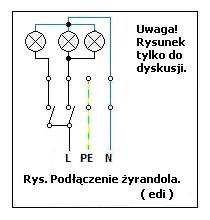Hello,
I wanted to ask how to connect the chandelier in a 3-wire configuration. In the simplest words, 3 cables stick out of the ceiling, which go to the box, and also 3 cables from the box go to the light switch. The chandelier would have, say, 4 bulbs, and it would light 0 (switch off) / 2 (on the first 'flap' of the switch) / and 4 on both 'flaps'.
I have searched a lot on the internet, but unfortunately there is either a 2-wire or 4-wire connection described everywhere. Some people said that a 3-wire connection is impossible, but I used to have a wiring diagram in this way, unfortunately I lost it ...
Does it need a special chandelier for such a connection? Are they universal in this respect?
If you need a diagram, please let us know - I will draw it.
Thank you in advance for your help.
Greetings.
I wanted to ask how to connect the chandelier in a 3-wire configuration. In the simplest words, 3 cables stick out of the ceiling, which go to the box, and also 3 cables from the box go to the light switch. The chandelier would have, say, 4 bulbs, and it would light 0 (switch off) / 2 (on the first 'flap' of the switch) / and 4 on both 'flaps'.
I have searched a lot on the internet, but unfortunately there is either a 2-wire or 4-wire connection described everywhere. Some people said that a 3-wire connection is impossible, but I used to have a wiring diagram in this way, unfortunately I lost it ...
Does it need a special chandelier for such a connection? Are they universal in this respect?
If you need a diagram, please let us know - I will draw it.
Thank you in advance for your help.
Greetings.



